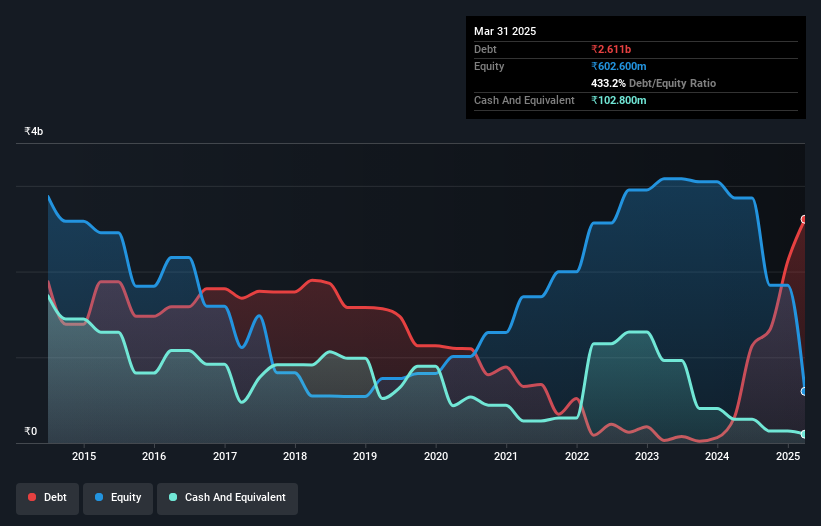
Warren Buffett famously said, 'Volatility is far from synonymous with risk.' So it seems the smart money knows that debt - which is usually involved in bankruptcies - is a very important factor, when you assess how risky a company is. Importantly, New Delhi Television Limited (NSE:NDTV) does carry debt. But the real question is whether this debt is making the company risky.
Our free stock report includes 3 warning signs investors should be aware of before investing in New Delhi Television. Read for free now.Why Does Debt Bring Risk?
Generally speaking, debt only becomes a real problem when a company can't easily pay it off, either by raising capital or with its own cash flow. If things get really bad, the lenders can take control of the business. However, a more frequent (but still costly) occurrence is where a company must issue shares at bargain-basement prices, permanently diluting shareholders, just to shore up its balance sheet. Of course, plenty of companies use debt to fund growth, without any negative consequences. The first thing to do when considering how much debt a business uses is to look at its cash and debt together.
How Much Debt Does New Delhi Television Carry?
You can click the graphic below for the historical numbers, but it shows that as of March 2025 New Delhi Television had ₹2.61b of debt, an increase on ₹306.1m, over one year. However, it does have ₹102.8m in cash offsetting this, leading to net debt of about ₹2.51b.

How Healthy Is New Delhi Television's Balance Sheet?
The latest balance sheet data shows that New Delhi Television had liabilities of ₹2.50b due within a year, and liabilities of ₹3.32b falling due after that. Offsetting these obligations, it had cash of ₹102.8m as well as receivables valued at ₹1.40b due within 12 months. So it has liabilities totalling ₹4.32b more than its cash and near-term receivables, combined.
New Delhi Television has a market capitalization of ₹8.38b, so it could very likely raise cash to ameliorate its balance sheet, if the need arose. But it's clear that we should definitely closely examine whether it can manage its debt without dilution. The balance sheet is clearly the area to focus on when you are analysing debt. But it is New Delhi Television's earnings that will influence how the balance sheet holds up in the future. So if you're keen to discover more about its earnings, it might be worth checking out this graph of its long term earnings trend.
View our latest analysis for New Delhi Television
In the last year New Delhi Television wasn't profitable at an EBIT level, but managed to grow its revenue by 26%, to ₹4.7b. With any luck the company will be able to grow its way to profitability.
Caveat Emptor
While we can certainly appreciate New Delhi Television's revenue growth, its earnings before interest and tax (EBIT) loss is not ideal. Its EBIT loss was a whopping ₹2.0b. Considering that alongside the liabilities mentioned above does not give us much confidence that company should be using so much debt. Quite frankly we think the balance sheet is far from match-fit, although it could be improved with time. However, it doesn't help that it burned through ₹2.2b of cash over the last year. So in short it's a really risky stock. There's no doubt that we learn most about debt from the balance sheet. But ultimately, every company can contain risks that exist outside of the balance sheet. Be aware that New Delhi Television is showing 3 warning signs in our investment analysis , and 2 of those are concerning...
If you're interested in investing in businesses that can grow profits without the burden of debt, then check out this free list of growing businesses that have net cash on the balance sheet.
Valuation is complex, but we're here to simplify it.
Discover if New Delhi Television might be undervalued or overvalued with our detailed analysis, featuring fair value estimates, potential risks, dividends, insider trades, and its financial condition.
Access Free AnalysisHave feedback on this article? Concerned about the content? Get in touch with us directly. Alternatively, email editorial-team (at) simplywallst.com.
This article by Simply Wall St is general in nature. We provide commentary based on historical data and analyst forecasts only using an unbiased methodology and our articles are not intended to be financial advice. It does not constitute a recommendation to buy or sell any stock, and does not take account of your objectives, or your financial situation. We aim to bring you long-term focused analysis driven by fundamental data. Note that our analysis may not factor in the latest price-sensitive company announcements or qualitative material. Simply Wall St has no position in any stocks mentioned.
About NSEI:NDTV
New Delhi Television
Engages in the television media business in India, the United States, Europe, and internationally.
Low and overvalued.
Similar Companies
Market Insights
Community Narratives




